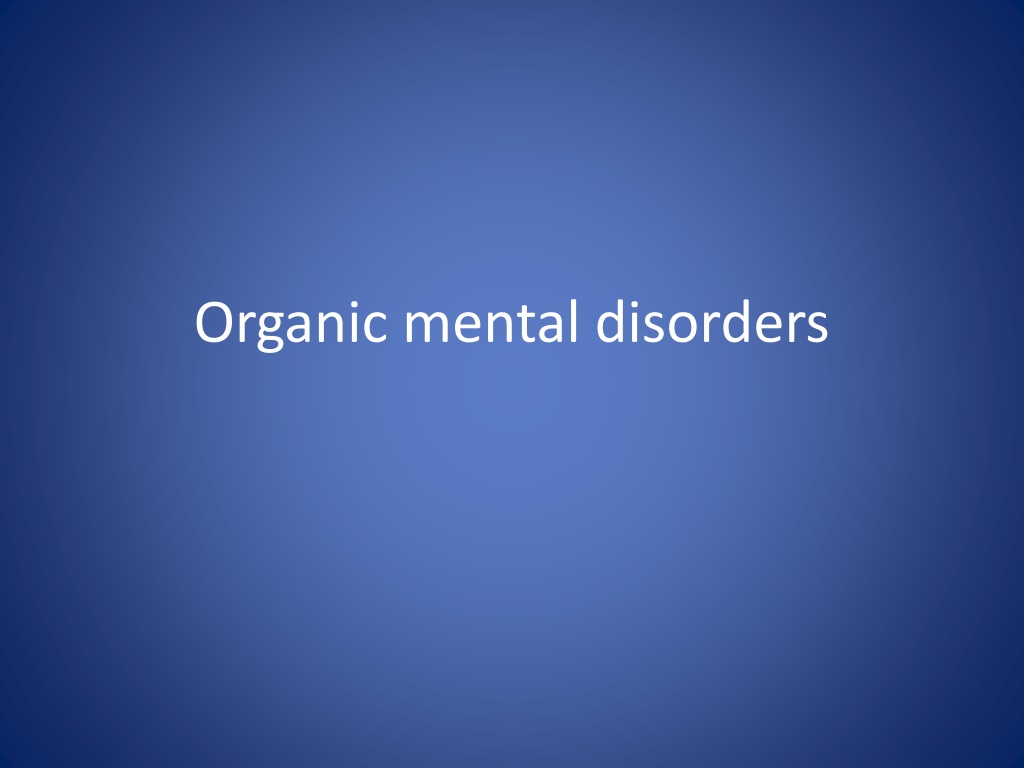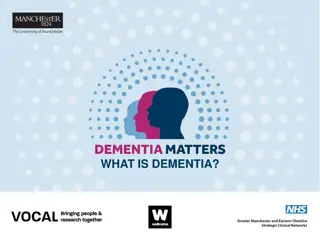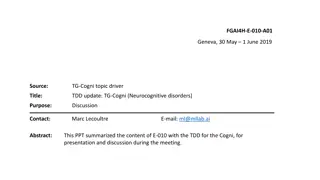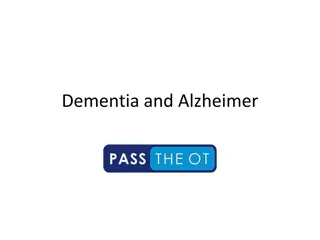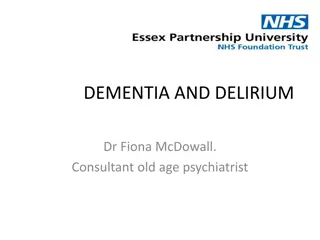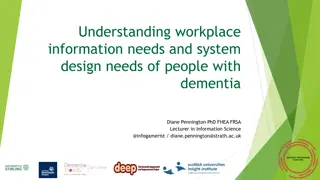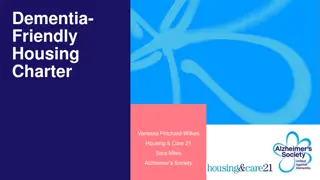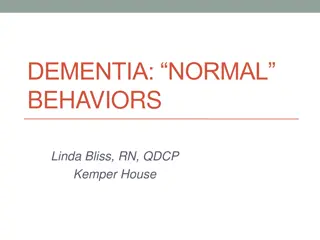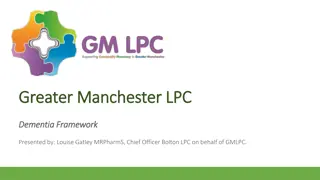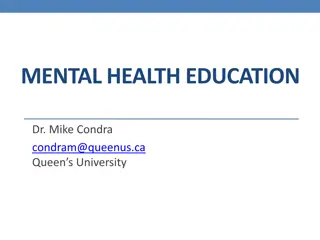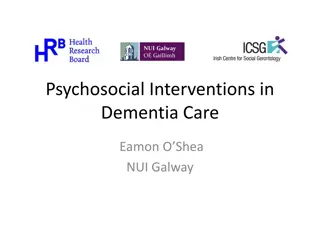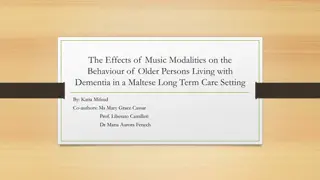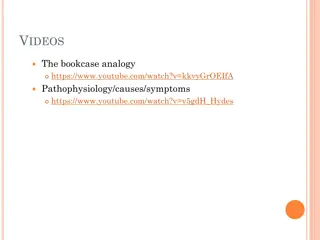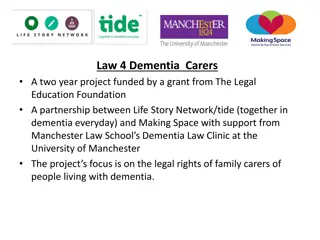Understanding Organic Mental Disorders and Dementia
Organic mental disorders encompass a range of conditions with a clear biological basis affecting brain function, manifested as cognitive impairments or behavioral changes. Dementia, a common type within this category, is characterized by a decline in memory and cognitive abilities. It is vital to recognize the symptoms and diagnostic criteria to provide appropriate care and support to individuals affected by these disorders.
Download Presentation

Please find below an Image/Link to download the presentation.
The content on the website is provided AS IS for your information and personal use only. It may not be sold, licensed, or shared on other websites without obtaining consent from the author. Download presentation by click this link. If you encounter any issues during the download, it is possible that the publisher has removed the file from their server.
E N D
Presentation Transcript
F00-F09 Organic, including symptomatic, mental disorders This block comprises a range of mental disorders grouped together on the basis of their having in common a demonstrable etiology in cerebral disease, brain injury, or other insult leading to cerebral dysfunction. The dysfunction may be primary, as in diseases, injuries, and insults that affect the brain directly and selectively; or secondary, as in systemic diseases and disorders that attack the brain only as one of the multiple organs or systems of the body that are involved.
Organic mental disorders Organic, including symptomatic, mental disorders: F00 Dementia in Alzheimer s disease F01 Vascular dementia P02 Dementia in other diseases classified elsewhere F03 Unspecified dementia F04 Organic amnesic syndrome, not induced by alcohol and other psychoactive substances F05 Delirium, not induced by alcohol and other psychoactive substances F06 Other mental disorders due to brain damage and dysfunction and to physical disease F07 Personality and behavioural disorders due to brain disease, damage and dysfunction F09 Unspecified organic or symptomatic mental disorder
Dementia Dementia is a syndrome usually of chronic and progressive nature characterized by a decline of memory and intellect. Diagnostic criteria of dementia: decline of learning new information decline of other cognitive functions (thinking, judgement, planning, organizing, processing of information) no disorder of consciousness affective disorders (impaired emotional control - lability, irritability, apathy, decline of social functioning) the symptoms evident for at least 6 months
F00-F03 Dementia Dementia (F00-F03) is a syndrome due to disease of the brain, usually of a chronic or progressive nature, in which there is disturbance of multiple higher cortical functions, including memory, thinking, orientation, comprehension, calculation, learning capacity, language, and judgement. Consciousness is not clouded. The impairments of cognitive function are commonly accompanied, and occasionally preceded, by deterioration in emotional control, social behaviour, or motivation. This syndrome occurs in Alzheimer disease, in cerebrovascular disease, and in other conditions primarily or secondarily affecting the brain.
Dementia The degrees of dementia: mild moderate serious Dementia is usually (80%) an irreversible process
F00 Dementia in Alzheimers Disease DAT = dementia of Alzheimer's type: the most frequent type of dementia primary degenerative cerebral disease of unknown etiology characterized with marked reduction of neurons, appearance of neurofibrillary tangles and senile plaques (beta-amyloid) especially cholinergic system is affected
DAT with Early Onset Dementia before the age of 65 Relatively rapid deterioration Aphasia, agraphia, alexia, apraxia
DAT with Late Onset Dementia after the age 65 Family history of DAT Slow progression, no insight Severe impairment of memory, sometimes confabulations
F00 Dementia in Alzheimer disease Dementia in Alzheimer disease (G30.-+) Alzheimer disease is a primary degenerative cerebral disease of unknown etiology with characteristic neuropathological and neurochemical features. The disorder is usually insidious in onset and develops slowly but steadily over a period of several years. F00.0* Dementia in Alzheimer disease with early onset (G30.0+) Dementia in Alzheimer disease with onset before the age of 65, with a relatively rapid deteriorating course and with marked multiple disorders of the higher cortical functions. Alzheimer disease, type 2 Presenile dementia, Alzheimer type Primary degenerative dementia of the Alzheimer type, presenile onset
F00 Dementia in Alzheimer disease F00.1* Dementia in Alzheimer disease with late onset (G30.1+) Dementia in Alzheimer disease with onset after the age of 65, usually in the late 70s or thereafter, with a slow progression, and with memory impairment as the principal feature. Alzheimer disease, type 1 Primary degenerative dementia of the Alzheimer type, senile onset Senile dementia, Alzheimer type F00.2* Dementia in Alzheimer disease, atypical or mixed type (G30.8+) Atypical dementia, Alzheimer type F00.9* Dementia in Alzheimer disease, unspecified (G30.9+)
Treatment of DAT A) Pharmacotherapy of cognitive symptoms 1. Cholinesterase inhibitors - ACHEI (rivastigmin, donepezil and galantamin) 2. Competitive inhibitors of NMDA receptors memantin 3. Ginkgo biloba (Egb 761) in combination with ACHEI or in patients with MCI
Treatment of DAT B) 1. Pharmacotherapy of non-cognitive symptoms Depression, anxiety - SSRI (citalopram, escitalopram, sertralin), SNRI (venlafaxin), NASSA (mirtazapin) Psychotic + confusional states - antipsychotics with minimal adrenolytic + anticholinergic effects (tiaprid, melperon, amisulpiride, risperidone, haloperidol, clozapine) Insomnia - non-benzodiazepine hypnotics (zolpidem, zopiclon) Epileptic seizures - carbamazepin, valproate 2. 3. 4. C) 1. 2. 3. Psychotherapy Reeducation of cognitive, emotional + behavioural disorders Family therapy Alzheimer s society
F01 Vascular Dementia F01 F01.0 F01.1 F01.2 F01.3 Vascular dementia Vascular dementia of acute onset Multi-infarct dementia Subcortical vascular dementia Mixed cortical and subcortical vascular dementia Other vascular dementia Vascular dementia, unspecified F01 8 F01.9
F01 Vascular Dementia Diagnostic guidelines: a) Presence of a dementia b) Uneven impairment of cognitive function + focal neurological signs c) Insight and judgement relatively well preserved d) An abrupt onset or a stepwise deterioration
F01 Vascular Dementia Associated features: a) Hypertension b) Emotional lability, weeping or explosive laughter c) Transient episodes of clouded consciousness d) Personality relatively well preserved, accentuation of previous traits (egocentrism, paranoid attitudes, irritability)
F01 Vascular Dementia F01.0 - after a succession of strokes or a single large infarction (cerebrovascular thrombosis, embolism or haemorrhage) F01.1 - more gradual in onset after a number of minor ischaemic episodes F01.2 - destruction in the deep white matter (Binswanger s encephalop.) F01.3 - mixed cortical + subcortical components
F01 Vascular dementia Vascular dementia is the result of infarction of the brain due to vascular disease, including hypertensive cerebrovascular disease. The infarcts are usually small but cumulative in their effect. Onset is usually in later life. Incl.: arteriosclerotic dementia F01.0 Vascular dementia of acute onset Usually develops rapidly after a succession of strokes from cerebrovascular thrombosis, embolism or haemorrhage. In rare cases, a single large infarction may be the cause. F01.1 Multi-infarct dementia Gradual in onset, following a number of transient ischaemic episodes which produce an accumulation of infarcts in the cerebral parenchyma. Predominantly cortical dementia
F01 Vascular dementia F01.2 Subcortical vascular dementia Includes cases with a history of hypertension and foci of ischaemic destruction in the deep white matter of the cerebral hemispheres. The cerebral cortex is usually preserved and this contrasts with the clinical picture which may closely resemble that of dementia in Alzheimer disease. F01.3 Mixed cortical and subcortical vascular dementia F01.8 Other vascular dementia F01.9 Vascular dementia, unspecified
F02 Dementia in Other Diseases Classified Elsewhere Diagnostic guidelines: a) Presence of a dementia b) Onset at any time of life c) Presence of features characteristic of one of the specified syndromes
F02 Dementia in Other Diseases Classified Elsewhere F02.0 Dementia in Pick s disease a) A progressive dementia b) A predominance of frontal lobe features (euphoria, emotional blunting, coarsening of social behaviour, disinhihition, apathy) c) Behavioural manifestations F02.1 Dementia in Creutzfeldt-Jakob disease a) Fairly rapid progressing over months to 1-2 years b) Multiple neurological signs (pyramidal + extrapyramidal, ataxia)
F02 Dementia in Other Diseases Classified Elsewhere F02.2 Dementia in Huntington s disease a) Family history of H s d. b) Onset at a relatively young age c) Involuntary choreiform movements d) Slow progression of dementia F02.3 Dementia in Parkinson s disease In severe cases, no particular distinguishing features
F02 Dementia in Other Diseases Classified Elsewhere F02.4 Dementia in human immunodeficiency virus (HIV) disease a) HIV infection b) Complaints of forgetfulness, slowness, poor concentration, difficulties with problem-solving and reading c) Apathy, social withdrawal, affective disorder d) Neurological signs (tremor, ataxia, hyperreflexia,...) General paralysis of the insane (GPI paralysis progressiva)
Symptomatic Dementia 1. Pharmacogenic dementia (anticholinergics, benzodiazepines, cytostatics, ...) Alcohol dementia (simplex, Korsakov, Wernicke sy) Intoxicant dementia of other etiology (CO, Pb, Hg, AI, solvents) Dementia at vitamin deficit (niacin-pellagra, vit. B12) Dementia of endocrinne origin (hypothyreosis, Cushing sy) Dementia due to dialysis 2. 3. 4. 5. 6.
Symptomatic Dementia 7. Metabolic dementia (hypernatremia, hypocalemia) D. at uraemia (uremic encephalopathy) D. at m. Wilson D. at liver encephalopathy D. due to hypoxia D. due to trauma 10. D. at epilepsy 11. D. due to infection (paralysis progressiva, human immunodeficiency virus disease, prion infection - Creutzfeldt-Jakob d., kuru) 12. D. at brain tumors 8. 9.
F02 Dementia in other diseases classified elsewhere Cases of dementia due, or presumed to be due, to causes other than Alzheimer disease or cerebrovascular disease. Onset may be at any time in life, though rarely in old age. F02.0* Dementia in Pick disease (G31.0+) A progressive dementia, commencing in middle age, characterized by early, slowly progressing changes of character and social deterioration, followed by impairment of intellect, memory, and language functions, with apathy, euphoria and, occasionally, extrapyramidal phenomena. F02.1* Dementia in Creutzfeldt-Jakob disease (A81.0+) A progressive dementia with extensive neurological signs, due to specific neuropathological changes that are presumed to be caused by a transmissible agent. Onset is usually in middle or later life, but may be at any adult age. The course is subacute, leading to death within one to two years.
F02 Dementia in other diseases classified elsewhere F02.2* Dementia in Huntington disease (G10+) A dementia occurring as part of a widespread degeneration of the brain. The disorder is transmitted by a single autosomal dominant gene. Symptoms typically emerge in the third and fourth decade. Progression is slow, leading to death usually within 10 to 15 years. Dementia in Huntington chorea F02.3* Dementia in Parkinson disease (G20+) A dementia developing in the course of established Parkinson disease. No particular distinguishing clinical features have yet been demonstrated. Dementia in: paralysis agitans, parkinsonism
F02 Dementia in other diseases classified elsewhere Dementia in human immunodeficiency virus [HIV] disease (B22.0+) Dementia developing in the course of HIV disease, in the absence of a concurrent illness or condition other than HIV infection that could explain the clinical features. F02.8* Dementia in other specified diseases classified elsewhere Dementia (in): cerebral lipidosis (E75.-+), epilepsy (G40.-+), hepatolenticular degeneration (E83.0+), hypercalcaemia (E83.5+), hypothyroidism, acquired (E01.-+, E03.-+), intoxications (T36-T65+), multiple sclerosis (G35+), neurosyphilis (A52.1+), niacin deficiency [pellagra] (E52+), polyarteritis nodosa (M30.0+), systemic lupus erythematosus (M32.-+), trypanosomiasis (B56.-+, B57.-+), uraemia (N18.5+), vitamin B12deficiency (E53.8+)
F04 Organic amnesic syndrome, not induced by alcohol and other psychoactive substances A syndrome of prominent impairment of recent and remote memory while immediate recall is preserved, with reduced ability to learn new material and disorientation in time. Confabulation may be a marked feature, but perception and other cognitive functions, including the intellect, are usually intact. The prognosis depends on the course of the underlying lesion.
F05 Delirium, not Induced by Alcohol and Other Psychoactive Substances Diagnostic guidelines: a) Impairment of consciousness and attention b) Global disturbance of cognition (perceptual distortions, illusions, hallucinations, impairment of abstract thinking and comprehension, disorientation for time + place) c) Psychomotor disturbances (hypo- or hyperactivity,...) d) Disturbances of sleep (reversal of the sleep-wake cycle) e) Emotional disturbances (anxiety, fear, irritability, apathy, perplexity) F05.0 Delirium, not superimposed on dementia F05.1 Delirium, superimposed en dementia F05.8 Other delirium F05.9 Delirium, unspecified
F05 Delirium, not induced by alcohol and other psychoactive substances An etiologically nonspecific organic cerebral syndrome characterized by concurrent disturbances of consciousness and attention, perception, thinking, memory, psychomotor behaviour, emotion, and the sleep-wake schedule. The duration is variable and the degree of severity ranges from mild to very severe. Incl.: acute or subacute: brain syndrome, confusional state (nonalcoholic), infective psychosis, organic reaction, psycho-organic syndrome Excl.: delirium tremens, alcohol-induced or unspecified (F10.4)
F05 Delirium, not induced by alcohol and other psychoactive substances F05.0 Delirium not superimposed on dementia, so described F05.1 Delirium superimposed on dementia Conditions meeting the above criteria but developing in the course of a dementia (F00-F03). F05.8 Other delirium Delirium of mixed origin Postoperative delirium F05.9 Delirium, unspecified
F06 Other Mental Disorders Due to Brain Damage and Dysfunction and to Physical Disease Diagnostic guidelines: a) Evidence of cerebral disease, damage or dysfunction, or of systemic disease b) A temporal relationship (weeks or a few months) between the development of the underlying disease and the onset of the mental syndrome c) Recovery from the mental disorder following removal or improvement of the underlying presumed cause d) Absence of evidence to suggest an alternative cause of the mental sy Types: organic hallucinosis, org. catatonic disorder, org. delusional (schizophrenia-like) disorder, org. affective disorders (manic, depressive, anxiety, emotionally labile), mild cognitive disorder (F06.7 - may precede, accompany, or follow a wide variety of infections and physical disorders)
F06 Other mental disorders due to brain damage and dysfunction and to physical disease Includes miscellaneous conditions causally related to brain disorder due to primary cerebral disease, to systemic disease affecting the brain secondarily, to exogenous toxic substances or hormones, to endocrine disorders, or to other somatic illnesses. F06.0 Organic hallucinosis A disorder of persistent or recurrent hallucinations, usually visual or auditory, that occur in clear consciousness and may or may not be recognized by the subject as such. Delusional elaboration of the hallucinations may occur, but delusions do not dominate the clinical picture; insight may be preserved. Organic hallucinatory state (nonalcoholic)
F06 Other mental disorders due to brain damage and dysfunction and to physical disease F06.1 Organic catatonic disorder A disorder of diminished (stupor) or increased (excitement) psychomotor activity associated with catatonic symptoms. The extremes of psychomotor disturbance may alternate. F06.2 Organic delusional [schizophrenia-like] disorder A disorder in which persistent or recurrent delusions dominate the clinical picture. The delusions may be accompanied by hallucinations. Some features suggestive of schizophrenia, such as bizarre hallucinations or thought disorder, may be present. Paranoid and paranoid-hallucinatory organic states and Schizophrenia-like psychosis in epilepsy
F06 Other mental disorders due to brain damage and dysfunction and to physical disease F06.3 Organic mood [affective] disorders Disorders characterized by a change in mood or affect, usually accompanied by a change in the overall level of activity, depressive, hypomanic, manic or bipolar (see F30-F38), but arising as a consequence of an organic disorder. F06.4 Organic anxiety disorder A disorder characterized by the essential descriptive features of a generalized anxiety disorder (F41.1), a panic disorder (F41.0), or a combination of both, but arising as a consequence of an organic disorder. F06.5 Organic dissociative disorder A disorder characterized by a partial or complete loss of the normal integration between memories of the past, awareness of identity and immediate sensations, and control of bodily movements (see F44.-), but arising as a consequence of an organic disorder.
F06 Other mental disorders due to brain damage and dysfunction and to physical disease F06.6 Organic emotionally labile [asthenic] disorder A disorder characterized by emotional incontinence or lability, fatigability, and a variety of unpleasant physical sensations (e.g. dizziness) and pains, but arising as a consequence of an organic disorder. F06.7 Mild cognitive disorder A disorder characterized by impairment of memory, learning difficulties, and reduced ability to concentrate on a task for more than brief periods. There is often a marked feeling of mental fatigue when mental tasks are attempted, and new learning is found to be subjectively difficult even when objectively successful. None of these symptoms is so severe that a diagnosis of either dementia (F00-F03) or delirium (F05.-) can be made. This diagnosis should be made only in association with a specified physical disorder, and should not be made in the presence of any of the mental or behavioural disorders classified to F10-F99. The disorder may precede, accompany, or follow a wide variety of infections and physical disorders, both cerebral and systemic, but direct evidence of cerebral involvement is not necessarily present. It can be differentiated from postencephalitic syndrome (F07.1) and postconcussional syndrome (F07.2) by its different etiology, more restricted range of generally milder symptoms, and usually shorter duration.
F06 Other mental disorders due to brain damage and dysfunction and to physical disease F06.8 Other specified mental disorders due to brain damage and dysfunction and to physical disease Epileptic psychosis NOS F06.9 Unspecified mental disorder due to brain damage and dysfunction and to physical disease Organic: brain syndrome NOS, mental disorder NOS
F07 Personality and Behavioural Disorders Due to Brain Disease, Damage and Dysfunction F07.0 Organic personality disorder Diagnostic guidelines: a) Consistently reduced ability to persevere with goal-directed activities b) Altered emotional behaviour (emotional lability, euphoria, irritability, outbursts of anger and aggression,...) c) Expression of needs and impulses without consideration of consequences or social convention d) Cognitive disturbances e) Marked alteration of language production f) Altered sexual behaviour (hyposexuality, change of sexual preference)
F07 Personality and Behavioural Disorders Due to Brain Disease, Damage and Dysfunction F07.1 Postencephalitic syndrome Residual behavioural change following recovery from encephalitis often reversible (apathy, irritability, some lowering of cognitive functioning, altered sleep pattern, a variety of neurological dysfunctions, ) F07.2 Postcontussional syndrome Occurs following head trauma Complaints of headache, dizziness, fatigue, irritability, difficulty in concentrating and performing mental tasks, impairment of memory, insomnia, reduced tolerance to stress, emotional excitement or alcohol, (sometimes associated with compensation motives)
F07 Personality and behavioural disorders due to brain disease, damage and dysfunction Alteration of personality and behaviour can be a residual or concomitant disorder of brain disease, damage or dysfunction. F07.0 Organic personality disorder A disorder characterized by a significant alteration of the habitual patterns of behaviour displayed by the subject premorbidly, involving the expression of emotions, needs and impulses. Impairment of cognitive and thought functions, and altered sexuality may also be part of the clinical picture. Organic: pseudopsychopathic personality, pseudoretarded personality Syndrome: frontal lobe, limbic epilepsy personality, lobotomy, postleucotomy
F07 Personality and behavioural disorders due to brain disease, damage and dysfunction 07.1 Postencephalitic syndrome Residual nonspecific and variable behavioural change following recovery from either viral or bacterial encephalitis. The principal difference between this disorder and the organic personality disorders is that it is reversible. F07.2 Postconcussional syndrome A syndrome that occurs following head trauma (usually sufficiently severe to result in loss of consciousness) and includes a number of disparate symptoms such as headache, dizziness, fatigue, irritability, difficulty in concentration and performing mental tasks, impairment of memory, insomnia, and reduced tolerance to stress, emotional excitement, or alcohol. F07.8 Other organic personality and behavioural disorders due to brain disease, damage and dysfunction Right hemispheric organic affective disorder F07.9 Unspecified organic personality and behavioural disorder due to brain disease, damage and dysfunction Organic psychosyndrome
F09 Unspecified organic or symptomatic mental disorder
